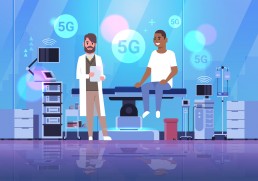How 5G Will Impact Healthcare
The COVID-19 pandemic has given us a glimpse into how 5G networks can help the healthcare industry better deliver information and care.
What Are the Benefits of 5G in Healthcare?
5G addresses many of the emerging needs of healthcare providers for connectivity services. These are faster speeds, lower latency, increased connection density, and the ability to guarantee quality of service (QoS) needed to create new use cases.
5G can be a key connectivity enabler for smarter healthcare scenarios delivered by a combination of Internet of Medical Things (IoMT), robotics, AI, and cloud. These solutions generate high volumes of alerts and data that can overwhelm healthcare providers’ ability to use them effectively and separate the noise from the signal.
Do We Really Need It?
Recent advances in connected-health technologies have enabled healthcare providers to improve collaboration and communication and empower new care-delivery models that make access to care more convenient, such as remote patient monitoring, virtual care, robotics, and telepresence.
However, with rising overall adoption and a wave of healthcare service requests due to COVID-19, some solutions will struggle to meet the complex demands created by the volume, variety, and velocity of health information on communication networks. To ensure the smooth running of mission-critical applications and devices, more sophisticated connectivity capabilities will be needed — and 5G can help to meet some of these challenges.
The Chinese government is looking to extend the country’s 5G telematic infrastructure by promoting its application to the healthcare sector. In Wuhan, where the COVID-19 outbreak began, 5G has enabled local authorities to connect all the digital instruments of the local health system and the medical staff to the network, providing extended connectivity at very high speeds.
How Does 5G Work in Healthcare?
These are the 5 benefits of 5G in the medical field:
- Emergency handling. Real-time exchange of data can be a key determinant in emergency situations, such as ambulance remote diagnosis and real-time health data transfer, as well as in conditions where teleconsultation is the only option (i.e. remote areas with limited health resources).
- Outpatient management. 5G is enhancing the seamless provision of care services outside the hospital. In comparison with other connectivity services, 5G enables faster and richer data sharing, as well as more complex data processing at the edge of the network, at the point of care. This enables VR and wearable sensors to be used for home-based rehabilitation, for example, as well as video consultation and real-time transfer of images, videos, and healthcare-related information from clinical-grade devices, giving patients faster and more accurate remote diagnosis and advice.
- Remote and extended practice. Researchers at the Technical University of Munich are testing 5G technology by equipping a test operating theater with prototypes of 5G-capable access points and terminals. Imagine undergoing surgery in London with a surgeon operating real time from New York. The speed and data capacity of 5G can enable remote care and treatment, combining tools and devices (e.g., robotics, IoMT) that effectively support smooth communication and procedures performed in real time, regardless of the location.
- Site connectivity and management. The value of clinical collaboration and communication within and outside the healthcare ecosystem has become essential to tackle the pandemic. 5G can be a game changer for healthcare enterprise services that need to support clinical collaboration and communications that are richer in content and need a reliable infrastructure for mission-critical applications and devices.
- Training and education. Skills building in the medical arena can potentially be enhanced through 5G by providing greater access to simulation activities by including VR and haptics in the education process and providing realistic, real-time remote tuition at the highest resolution.
As the number of connected devices and networks grows, 5G will bring both benefits and challenges in terms of network and data security. This will make it essential for healthcare organizations to evaluate risks and vulnerabilities around the availability of and access to patients’ health data.
So, before embarking on a 5G project, healthcare organizations should evaluate applications, use cases, and ecosystem requirements against the technology solution plan, as well as current connectivity and security management capabilities.
Contact us if you would like to know more about 5G and how we can help you to turn the capabilities of 5G into new services in healthcare. Silvia Piai
How Life Sciences Must Digitally Reinvent to Deal with COVID-19
After major public health emergencies in recent years, such as the 2012 MERS coronavirus outbreak in Saudi Arabia and the 2014 Ebola outbreak in Western Africa, we’d hoped we would be better equipped for the next one.
But the outbreak of the new coronavirus has caught us unprepared, causing profound disruptions on multiple fronts. This time we have no choice but to address the crisis with a more sustainable approach, building a stronger and more resilient global ecosystem to respond to health emergencies.
What Are the Core Expectations of the Life Sciences Industry?
The life sciences industry is at the frontline of the global fight against COVID-19, and is expected to operate at full speed to help healthcare systems around the world handle the pandemic and minimize its impact as soon as possible. While there is still no effective treatment against the novel coronavirus, all eyes are on pharma as the industry searches for a cure.
The industry is struggling to speed up efforts in many directions in parallel. Companies have to operate around the clock — whether to develop rapid diagnostic tests, repurpose existing therapies for COVID-19, or discover specific treatments or vaccines.
Meanwhile, many ongoing clinical trials in non-COVID-19 therapeutic areas have been put on hold.
Life science companies are also under enormous strain to handle supply chain operations to ensure reliable supply of critical products both for emergency and ongoing medical needs. Organizations will also need to expand production and distribution capacity for future therapies currently under development.
What’s the Way Forward for European Life Sciences Organizations?
During these times of crisis, life sciences organizations need to rapidly mobilize their capabilities simultaneously across a broad range of tasks and business areas. This can only be achieved by leveraging the power of technology and by expanding intelligent collaboration to unprecedented levels.
How can European life sciences organizations fast-track efforts to survive during the crisis and successfully adapt to the new normal in the post-pandemic era?
IDC has developed a reverse COVID-19 fast-track approach for life sciences, to take industry efforts to scale across the following key pillars: Data, Infrastructure, Vision, Operations, and Collaboration. These key pillars can be acronymized as the backronym of COVID:
- Data at scale: Data and analytics are the key weapons in the fight against COVID-19. The ability to harness the power of multisourced data at the largest possible scale will be a key determinant of success. The use of real-world data must also be enhanced to support the generation of critical evidence needed to accelerate time to market for products in all therapeutic areas.
- Infrastructure at scale: Organizations will need to establish scalable, high-performing, and secure ICT infrastructures to ensure the rapid deployment of new collaborative and extended work models. Business solutions’ modularity and scalability, alongside agile delivery models such as cloud, will facilitate rapid adaptation to growing and changing demands.
- Vision at scale: Having a vision shared on a broad scale will be essential for success. It’s also imperative that companies elaborate a longer-term vision, looking beyond the current emergency, and start to build “ecosystem-aware” strategies to strengthen their R&D and operational capabilities.
- Operations at scale: The COVID-19 crisis calls for more intelligent, data-driven systems for faster and more effective decision making, and reinforces the need to automate operations across the whole value chain. Life sciences firms will need to rely on new and more sophisticated “automation toolkit” technologies such as RPA, workflow integration platforms, AI, and the related business and IT services.
- Collaboration at scale: The COVID-19 pandemic has made global collaboration a must for the life sciences industry. Intelligent use of more mature models, such as cloud-based secure collaboration platforms, will be central to bring data, infrastructure, vision, and operations to the necessary scale to quickly overcome the current crisis. In fact, our framework positions intelligent collaboration as a cornerstone of success in the battle against COVID-19:
IDC’s “Reverse COVID-19 Fast Track” for Life Sciences

How Do We Prepare for the New Normal?
Harnessing the power of ICT and mastering intelligent collaboration at scale is imperative to achieve the necessary scale, scope, and speed of efforts during the crisis. But companies must also look beyond the immediate impact and start planning for the post-pandemic era.
Forward-looking organizations must make their strategies more “context aware,” adapting to the broader ecosystem-wide vision and dynamics in the new normal.
The sustainable impact will depend on the broad-scale availability and interoperability of data, scalability of infrastructures and solutions, and agility and resilience of supply chain operations — all led by a broadly shared ecosystem-wide vision and intelligent multistakeholder collaboration.
Although the pandemic is putting enormous pressure on the industry, it also presents major opportunities for life sciences organizations and their technology partners in Europe and beyond.
If you would like to learn more about opportunities, best practices, and essential guidance, please see our dedicated research program IDC Health Insights: European Life Science and Pharma, or contact us directly: Nino Giguashvili or Silvia Piai.
The Frontline CIO Interview - Charities
In the latest of our interviews with IT leaders from key sectors affected by the Coronavirus pandemic, we look into the Charity sector and talk to Paul Smith, who has been with the UK Lifeboat institution RNLI during a period of rapid change. The charity sector has been badly affected by the impact of the pandemic, with revenues falling across the board as fundraising activities stop, and the nation’s focus turns to those charities supporting NHS workers and providing vital PPE. I spoke to Paul as he was preparing to take on a newly created role designed to navigate the course of this historic organisation into the digital age.
Who are you, what’s your background, what organisation do you work for and what’s your role?
My name is Paul Smith, I work for the Royal National Lifeboat Institution (RNLI), I have been the Head of IT for nearly four years, and am now taking up a new role as Head of Digital and Technology Futures which is a very exciting new role for me and for the organisation.
Since you joined RNLI, what do you think the biggest change has been in terms of how the organisation views technology (up until the pandemic)
The RNLI is quite a traditional organisation, which comes from a history of saving lives at sea for almost 200 years faced with all kinds of challenges, and with that comes quite a complex legacy technology estate. Part of my role has been about unpicking and modernising this with a view to now setting the path for what next generation lifesaving, powered by technology could look like. I think the RNLI now sees and is ready for the role that technology can play in this. A significant proportion of our strategic change portfolio as an organisation now includes technology initiatives of various flavours, so the importance now placed on technology as a catalyst and augmenter of the organisation’s capability is clear and encouraging to see. In short, technology is critical now to the RNLI, more so than ever before, and we see it as both a real enabler of our mission and differentiator within the charity sector.
What improvements are you most proud of from your time in that role?
I now have a team capable of delivering on any tough questions asked of them by the organisation. We’ve gone back to basics in many areas, externally benchmarking ourselves with a real desire to ensure that those things are right before we move on to anything else such as resetting the bar. We focussed on organisational outcomes and technology building blocks which are ‘fit for business’, and ensuring the teams had the ability to ‘up-skill’ in a way which suited them best so that they could rise to the organisation’s challenges when called upon. This also means they are well placed from a motivation, personal and career development perspective too. Risks are managed and opportunities exploited accordingly in what we call a “no regrets” investment of our valuable donors funding. We know exactly why we make significant technology investment decisions, understanding how they map to our capability and outcomes clearly.
What do you find surprises people about your organisation and how it uses tech?
I would say firstly the breadth of the organisation – people don’t always understand or have visibility of all we do. For example, we are a Search and Rescue Service, a Fundraiser, an Educator and Trainer, a Hotelier, a Boat Builder, a Logistical and Supply Chain service, a Lifeguard Service and also an international influencer and cause for good. That all needs underpinning by appropriate technology. This is probably closely followed by our very diverse user demographic which includes all ages, backgrounds, beliefs and technical capabilities. Each presents their own unique challenges, perspectives and opportunities to power the organisation’s mission.
How have you responded to the remote working challenge of the pandemic?
My team have been tremendous. I know I would say that, but they truly have, supported by a very understanding and pragmatic user base. Luckily, from a technology perspective we had many of the foundations already in place for what we needed to do, as a result of work already completed, or in progress, due to previously identified risks and opportunities. The focus moved more with a sense of urgency to enablement, support and education to ensure we were getting the most from our platforms and that users could seamlessly do what they needed to, in a way which worked for them. The pandemic presented us with a compelling event, sense of urgency and common cause. There as an organisational will to become more digital, almost overnight, so that we could continue to work as expected. So, for once we could visibly see that traditional change management model work in real life, albeit in an expedited way!
Have you furloughed many IT staff – how did you manage that and how are you keeping those staff engaged?
As an organisation we had furloughed staff, in the region of 30% in fact. We had to take some pretty tough views on critical activity versus activities which quite frankly had less urgency around them, or that we could accept some pain for a short period through pause or slowdown. We care about our people deeply, so these things are never easy. The status of needs is never static – so we have to stay flexible, keep assessing the landscape and be dynamic in response with the appropriate sense of urgency. Interestingly the response from our staff has been varied from gratitude for the ability to care for loved ones at home, to more challenging situations for lone individuals, or through the culture shift we find ourselves experiencing from this new operating model where we have many people experiencing working from home for the first time. We also make sure that as line managers we touch base with our people to check in on them, keep them up to speed and to also invite them to that ‘virtual coffee session’ for a chat with their work friends and colleagues. There are clearly rules about what staff can and can’t do on furlough, but we’ve seen many taking the opportunity to access learning platforms to do a bit of personal development!
Will the effect of the pandemic change your priorities as an IT organisation?
To an extent. It certainly enables a renewed clarity. This is an opportunity to assess what is important versus what we thought was important and what would really ‘move the needle’. It has resulted in decisions to change focus and to throw more weight behind some existing initiatives and others that previously had been in the ‘not just yet’ pile. That has also been borne out of necessity too, whether that’s a reduced income outlook or uncertainty around the future – be that for the organisation or the people and ecosystem we rely so much on to be effective. We see it as an opportunity to take stock, re-prepare ourselves and to come out fresh and fighting with the technical capabilities we need afterwards. The new dispersed organisational operating model has certainly demonstrated our true ability through more digital ways of working and collaboration, which we are all very excited about.
Where next for you and your organisation?
Firstly we want to ensure that we learn from Covid-19, and make sure we remember what we are capable of when we need to move quickly. I am looking forward to setting up the new “Digital and Technology Futures Department” and laying out the strategic path for the organisation across various technology landscapes such as Digital Marketing and Income Generation, Lifesaving, User Enablement and other underpinning technology capabilities to drive the organisation forward as we approach our 200th birthday and beyond.
4 Critical Success Factors for Sustainable and Resilient Cities
Environmental sustainability goals have driven cities digital innovation since the early days of smart cities programs. However, natural and man-made disasters, such as floods, earthquakes, terrorist attacks, and currently the COVID-19 pandemic, have turned the attention of city executives towards resilience.
The Pendulum Swings: From Sustainability to Resilience
Mayors, city managers, and city innovation and technology executives started smart city programs to reduce energy consumption, GHG emissions, and improve water conservation. And rightly so, given that urban areas account for 60%-80% of global energy consumption and 70% of the world‘s greenhouse gases while occupying just 3% of its land.
But more recently, disasters caused by climate change, terrorist attacks, and, most of all, the current pandemic have made resilience a strategic priority for city executives.
The two concepts are tightly linked, but different. Resilience is the ability of a city to bounce back after a shock that requires everybody’s attention. Sustainability is about embracing a trajectory that leads to positive developments in the long term.
In essence, a shock-centric view of resilience speaks of the city’s ability to react when something sudden and bad occurs, such as COVID-19. Sustainability is about investing in long-lasting changes to city plans, services, and operations to address chronic stresses, such as water scarcity or income inequality, that jeopardize quality of life and economic growth in the long-term. And by doing so, it proactively reduces the risk of shocks.
So, by investing in sustainability, cities create the conditions for improved resilience to both shocks and stresses. For example, a city at risk of flooding and shoreline erosion could build redundant drain capacity that may absorb torrential rain (around 10% of the world population live in coastal areas that are less than 10 meters above sea level). It can invest in man-made dams that may increase short-term resilience to high tides and in water management systems that use AI and IoT to trigger alerts and generate actions when water levels rise above certain points. Or it can invest in sustainability by taking care of the wetlands that surround it. And it can convert concrete surfaces into porous turf that absorbs water runoffs.
What are Those Factors?
European cities that want to proactively bring sustainability and resilience together must consider four critical success factors:
Ecosystem collaboration
Cities must work across departments and with regional and national governments. They must collaborate with their ecosystem — utilities, transportation companies, real-estate and engineering companies, financial institutions, waste management contractors, and the broader business community. Collaboration must be leveraged to test and scale new business, funding, and service delivery models.
That is because cities are systems of systems. They are characterized by complex interdependencies. As a result, investing in sustainability requires taking a multifaceted approach.
The EU Green Deal provides a useful guide of how many interdependent perspectives city mayors and managers must consider when dealing with sustainability. For instance, a city that promotes usage of micro-mobility and public transport will not only reduce GHG emissions, but also free up parking space that can be converted into parks and urban farming. Or a city that invests in well-connected affordable housing will bring together safety, inclusion, green spaces, and economic development for the community.

Technology innovation
Investing in technology innovation will help city executives accelerate the path to sustainability. The West Midlands Sustainability Roadmap 2030 includes investments in technologies, such as electric vehicles and 5G, to enable low carbon living.
Recent analysis by the World Economic Forum states that “Emerging construction technologies such as 3D printing, robot bricklayers, self-driving bulldozers – and solutions related to the internet of things (IoT) and artificial intelligence (AI) that could bring down operational and maintenance costs” make affordable housing a reality in cities. Valencia‘s early investment in digital twin and data-driven decision making for sustainable water management helped ensure water resilience during the COVID-19 emergency.
Dutch cities’ iconic bike paths are being converted to recycled plastic surfaces. These roads can reduce carbon emissions caused by concrete, enable the re-use of plastic waste, increase the durability of paths, increase storm water absorption, and reduce the cost of installation because of the light modular material.
Community engagement
Engaging the community will make business and technology innovation meaningful, inclusive, and scalable. Not all technology and business model innovations work well in all contexts. Small communities are very different from metropolitan areas. And even within the same city there are socio-economic differences by neighborhood.
Cities should apply user-centric paradigms, such as socio-technical innovation and design thinking. These empower citizens and communities to embrace innovation, rather than imposing change from the top down.
For instance, Milan started to retrofit buildings with energy saving technologies to reduce the city carbon footprint and, in the process, increased citizen participation. Community engagement will be particularly important in encouraging local consumption and production, which is fundamental to the COVID-19 crisis recovery.
Policy and regulatory reforms
Rethinking regulatory frameworks will impact how cities and commercial enterprises prioritize sustainable solutions and operations and how citizens change their behavior. Some examples of these regulations are the forthcoming EU Green Deal and the EC COVID-19 recovery financial package.
Coordination between cities, regions, and national governments will be key. Spain, for example, recently unveiled an ambitious green energy bill that aims to draw 100% of the country’s electricity from renewables by 2050.
Resilience to short-term shocks must be combined with sustainability for long-term stresses. European cities that want to seize the COVID-19 recovery phase to bring the two together must collaborate with the ecosystem, innovate, ensure a clear regulatory framework, and most important of all engage with citizens.
To learn more take a look at IDC European Technology for Sustainability and Social Impact research or contact us.








